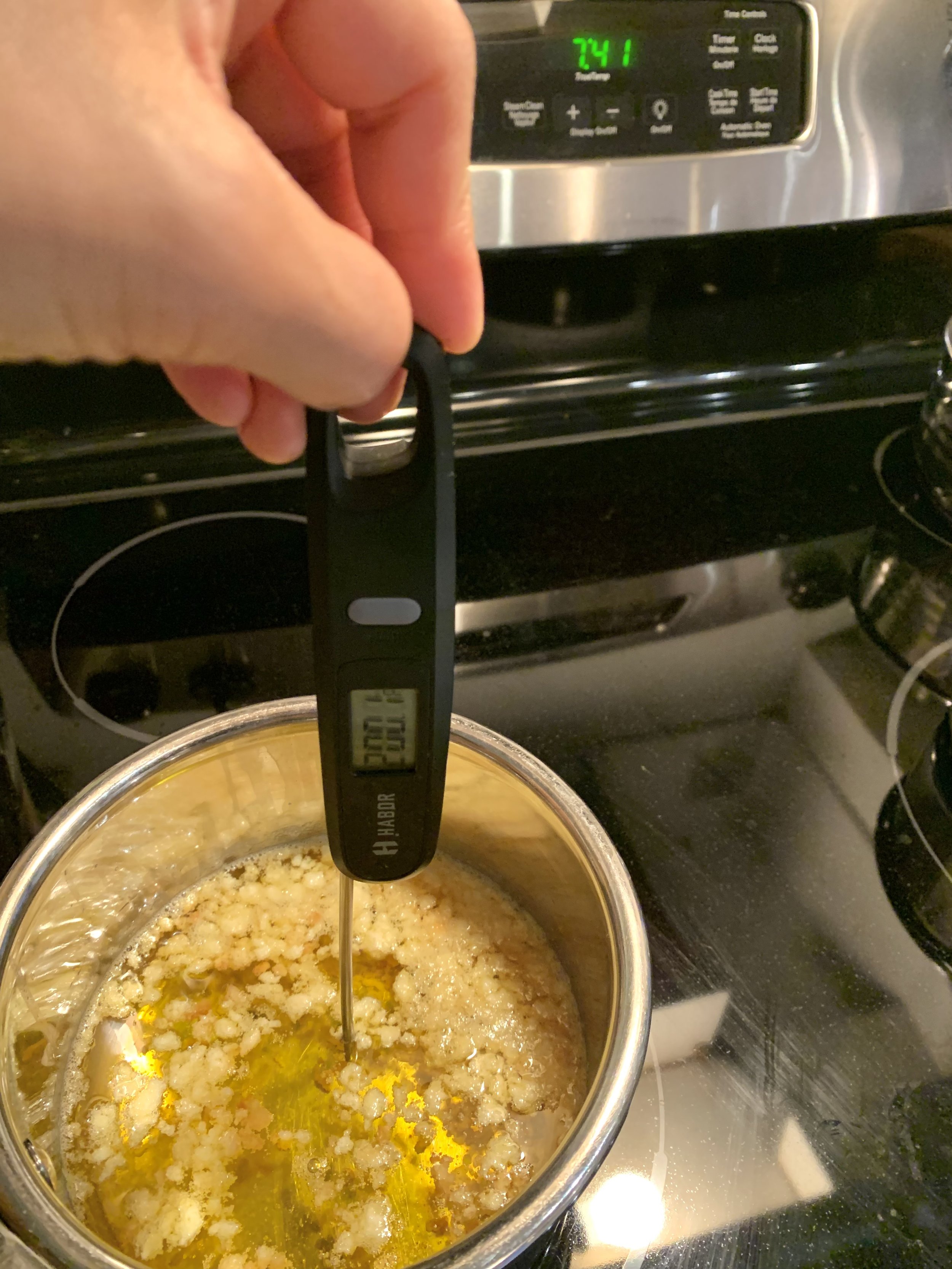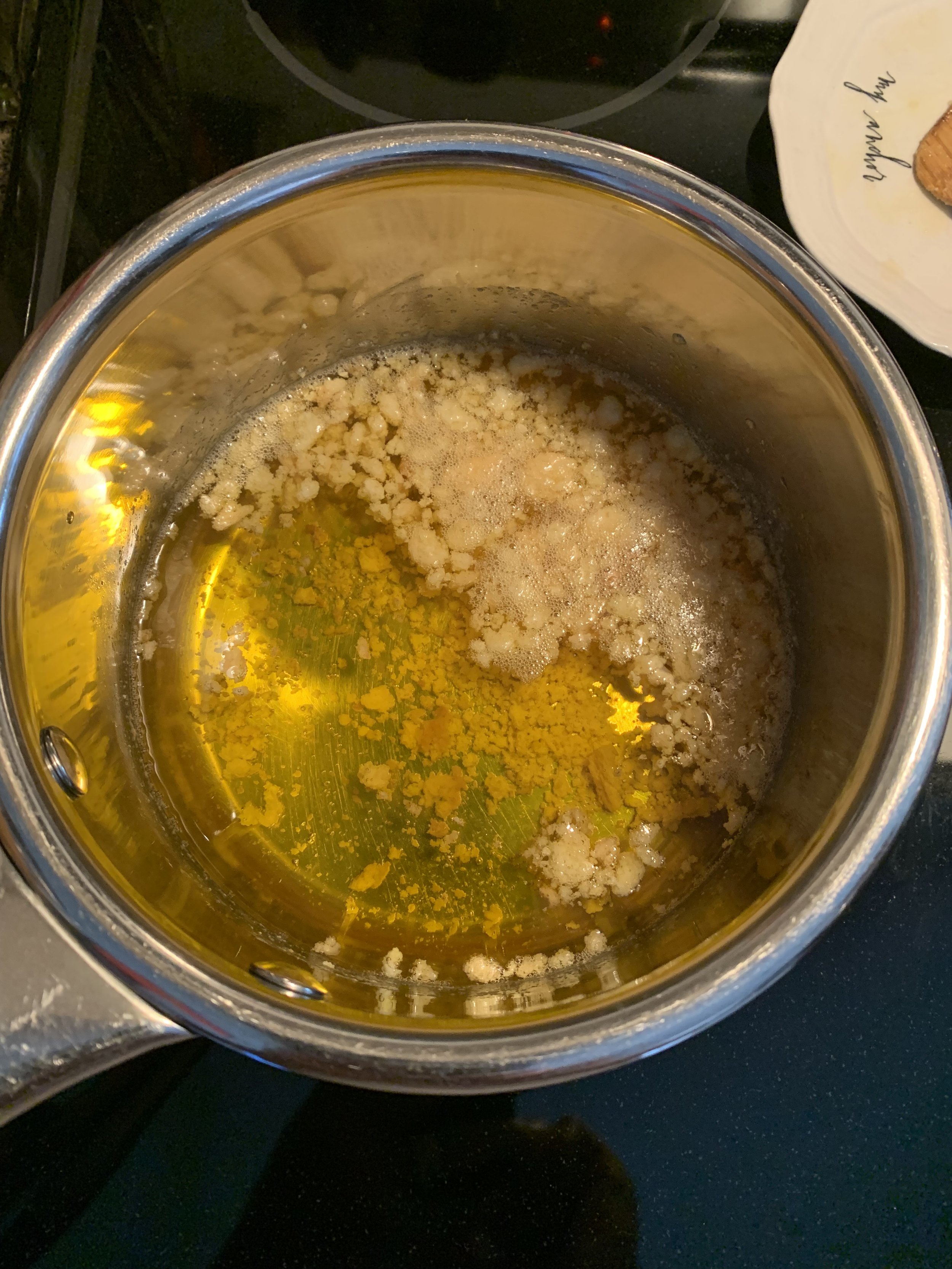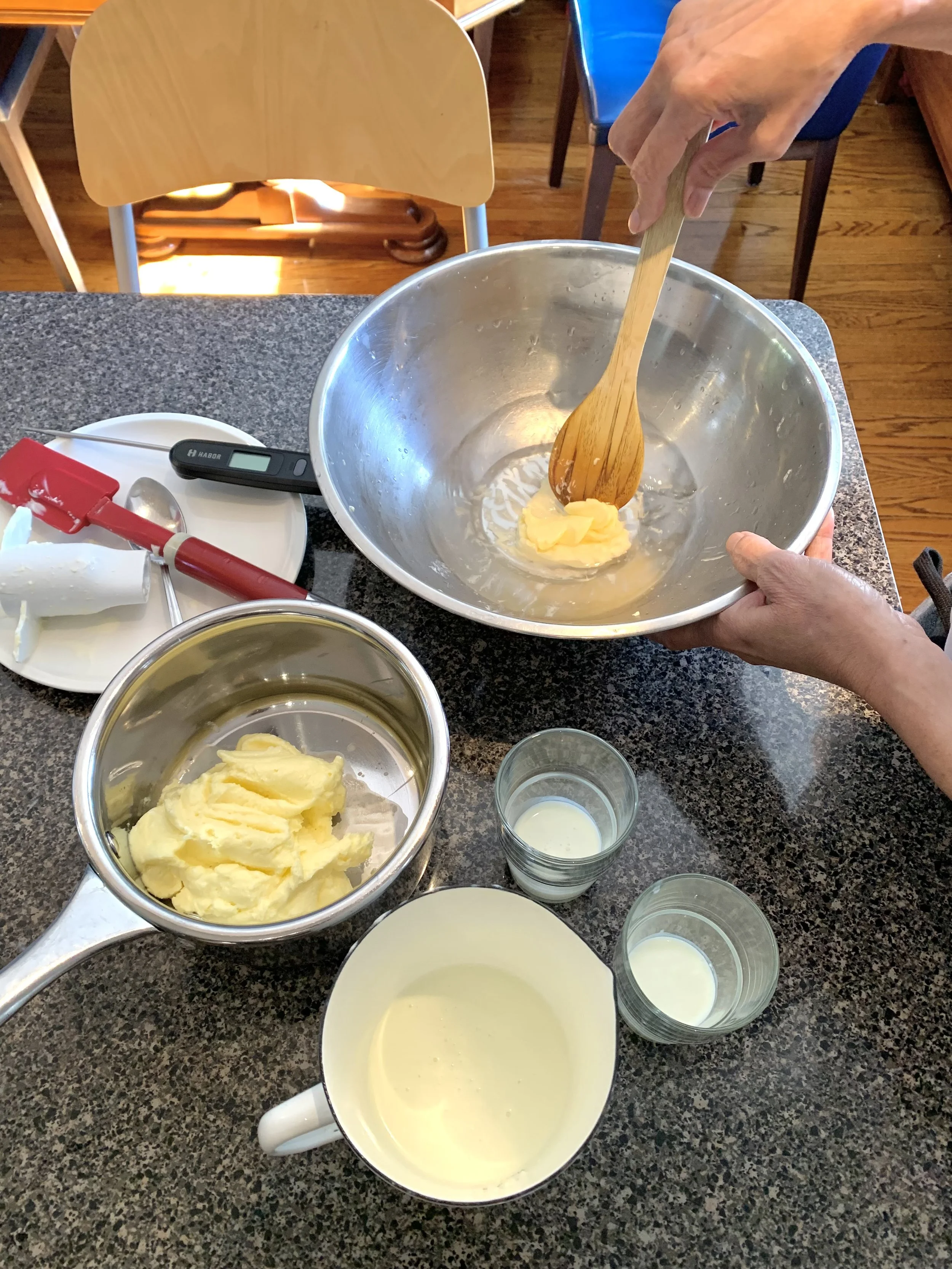Ghee: Benefits and How to Make
Hi and welcome! I’m Evangeline—mom, Registered Massage Therapist, Yoga teacher, and lover of all things health and wellness. I started this blog back in the early days of Covid19 as a way to stay in touch with my clients, and it’s grown into a space to share what I love most. Here you’ll find simple, nourishing recipes I make for my family, sprinkled with Ayurveda and Yoga wisdom. My hope is that these posts inspire you to care for yourself in small, joyful ways and feel a little more balanced in everyday life.
Updated: june 18, 2025
Ghee: A Nourishing, Time-Tested Fat
Ghee has gained well-deserved popularity in recent years. It’s simply clarified butter—made by gently heating butter to evaporate water and remove milk solids. What remains is a pure, golden fat rich in nourishment and health benefits.
For decades, the low-fat trend shaped mainstream dietary choices, but this has since been widely debunked. Current research highlights the importance of healthy fats like ghee and olive oil for overall well-being. Meanwhile, artificial trans fats—commonly found in margarine and processed foods under labels like "partially hydrogenated oils"—have been deemed unsafe for consumption by the FDA since 2013.
Choosing time-tested, wholesome fats like ghee is a meaningful step toward supporting your long-term health.
Bridging Ancient Wisdom and Modern Science
Modern research shows that ghee is considered a neutral fat—it has not been proven to contribute to heart disease. While ghee is high in saturated fat, medical science is still exploring the complexities of which types of saturated and unsaturated fats are truly beneficial, especially when it comes to cooking. Recent studies reveal that it’s oxidized LDL cholesterol, not cholesterol itself, that poses a major risk factor for atherosclerosis.
Long before science began to explore these nuances, the ancient seers of Ayurveda recognized that butter was a heavy fat that needed to be clarified. Through this process, they arrived at ghee—a fat that Ayurveda has cherished for thousands of years as the finest for human consumption. Ghee is believed to nourish all of the body’s tissues and, as modern research is beginning to confirm, offers a range of valuable health benefits.
Making ghee from grass-fed butter provides higher levels of Vitamin K2, a nutrient essential for supporting brain and heart health, as well as building strong bones. Ghee is also very low in lactose and casein, making it a potentially suitable option for those with dairy sensitivities. Ongoing research continues to highlight the nutritional value of ghee and its many potential health benefits.
Every month or so, I make a fresh jar of ghee. When I have the time, I like to make it from scratch using cultured butter, which starts with culturing the cream before churning it into butter. If time is short, I simply use store-bought, grass-fed organic butter. I first learned how to make ghee during a marma therapy course in Sarnia, taught by my Ayurvedic teacher, Vaidya Rama Kant Mishra. I remember him emphasizing that the stove must always stay at a very low temperature throughout the entire process. Slow cooking cultured butter over low heat is the traditional and preferred way to make ghee.
What the Science Says About Ghee
1. A “neutral food”- not proven to increase risk of heart disease.
2. Ghee has a high smoke point of 485°F (252°C), making it an excellent and stable fat for cooking at higher temperatures without breaking down or producing harmful compounds
3. High in short-chain fatty acids that quickly get converted to energy, thus not settle readily in the fat tissue.
4. Rich in butyrate, or butyric acid, one of most beneficial short- chain fatty acids, which has shown to help decrease inflammation, promote good bacterial growth, but inhibit bad bacterial growth in the gut, and therefore promotes brain health.
5. Contains good cholesterol. The brain and hormones are made of cholesterol, so we must think differently now about cholesterol. Not all cholesterol is bad for you. Only the oxidized cholesterol is proving to be problematic.
6. Contains high levels of omega-3 fatty acids. Omega-3 helps decrease levels of unhealthy cholesterol.
7. Rich in fat soluble Vitamins A, D, E and K2. Vitamin K2 is critical in supporting the health of your brain and heart and building strong bones.
8. Contains CLA, conjugated linoleic acid, which helps prevents inflammation in arterial walls and hardening of arteries.
9. Very low in lactose and casein and may be tolerated if allergic to milk.
What Ayurveda Says
What renowned Ayurvedic doctor and my teacher, Vaidya Mishra, says about ghee:
1. Ghee pacifies pitta and vata, and is not kapha aggravating - given proper preparation and combining.
2. Cleansing, alkalizing and cooling.
3. Enhances digestive fire.
4. Cools and lubricates the stomach wall.
5. Nurtures and cleanses blood tissue.
6. Ghee is a great rasayana, or rejuvenator, for the eyes.
7. Increases physical stamina.
8. Supports mental function: learning, memory and recall, nourishing to the brain (medhya)
9. Nourishes all the bodily tissues- rasa (plasma), rakta (blood), mamsa (muscle), meda (fat), asthi (bone), majja (nerve tissue), shukra (reproductive tissue).
9. Enhances complexion and glow of the face and body.
10. Increases longevity because it helps make ojas, the most subtle element of the body. Ojas gives us strength and immunity
11. Charak Samhita, an ancient Ayurvedic text, describes ghee as the best fat for human consumption- snehuttamam, as it has the perfect balance of soma and agni.
Over a period of about 4 hours, the temperature of ghee will rise gradually. Here at 200°F most of the water has evaporated and milk solids are floating at the top and some at the bottom, revealing ghee’s liquid golden colour. At this point it the ghee is almost done.
In Vaidya Mishra’s, SVA (Shaka Vansiya Ayurveda) family tradition, he spoke of three types of ghee used for different purposes:
1. Mridhu paka- soft cooked ghee containing some water used in celebrations and for Ayurvedic medicinal ghee; this ghee has a shelf life of only 2 weeks.
2. Madhya paka- has no water and should not be eaten raw; for everyday cooking and can be kept at room temperature for up to 6 months.
3. Khar paka- ghee that is slightly toasted, but not burnt; can be eaten raw and is good for travelling.
When making ghee let the butter slow cook in very low heat, stirring occasionally. Bubbles will rise naturally, and more so when stirred. Notice the light golden brown milk solids that have separated. Stop stirring when most of the solids are at the bottom. This ghee is ready to strain.
As with any food, ghee should be enjoyed in moderation. Fats, along with protein and carbohydrates are the three essential macronutrients your body needs. The wall of every single one your trillions of cells are made of a fat and protein compound and your hormones are made up of cholesterol. It is unfortunate that cholesterol is thought of as a “bad thing”, when in fact it is, once again, it is only the oxidized cholesterol that is bad. Fats are found in foods rich in protein like meat, fish, eggs, dairy, nuts and seeds. Depending on your lifestyle and routine, fats can be 20-30% of your meal.
How to Make Ghee & Cultured Ghee
Ingredients
Grass-fed, organic butter, or ideally organic cultured butter, and if possible grass-fed. If you would like to make **cultured butter yourself, follow my recipe on how to make yogurt, but instead of using milk you would culture whipping cream (35% milk fat) to make yogurt cream. Scroll down below on how to make **cultured butter from scratch.
Instructions
1. Place butter in a stainless steel pot on the lowest heat setting of your stove top. I find with my stove 1 pound to 1 ½ pounds of butter will take about 6-8 or up to 12 hours to turn into ghee. The more butter the longer the time.
2. During the process of making ghee, milk solids will rise to the top and settle at the bottom, and water will evaporate. Stir only occasionally. Bubbling can occur when stirred. Foaming will appear, but let that naturally disappear. This is all good. Just don’t let the butter burn. When most of the solids are at the bottom, don’t stir down at the bottom any longer.
3. As the water gradually evaporates the ghee will become more clear and the milk solids will turn a golden brown colour. The ghee will heat up quickly as temperature maintains at about 100° C/212°F, and once all the water has evaporated. I’ve had this happen before when the most of the milk solids became quite dark, almost black, which meant the ghee had burned, and unfortunately I had to throw it out.
4. Strain when the ghee is clear and milk solids are golden brown colour. If the ghee drops below 200F the fat will crystallize, so only wait a few minutes after ghee is done to strain. Strain ghee into a glass jar, filtering the solids with an 8 layer cheese cloth or a piece of plain neutral fabric covering a small strainer. Discard the milk solids.
5. Rinse the cloth with hot water, and soak with soapy hot water, to reuse for future.
6. Do not cover until the ghee cools to keep moisture from getting into the ghee. Once covered and completed, store ghee in the refrigerator to evenly solidify the ghee, preventing layers.
STORAGE
Keep unused ghee covered in the refrigerator.
Ghee can be kept at room temperature in the cupboard for several months for use in your cooking. If you plan on using ghee only once in a while, keep in the refrigerator, only taking out what you need at the time to prevent condensation going back and forth.
**How to Make Cultured Butter
To make cultured butter, first, follow the recipe on how to make yogurt, but use 1 L whipping cream (organic, grass-fed if you can get) with 1 cup of yogurt starter to culture it, or follow instructions on your powder yogurt starter. After making yogurt cream, follow the steps below:
Refrigerate the (cultured) yogurt cream for at least 6 hours to let cool. I find doing this overnight is best so when you wake up in the morning the yogurt cream is set, then you cover it and put in the fridge to cool for the day. When you’re done work, or you are ready to spend 4 minutes to process the yogurt cream into butterfat and buttermilk, and another 10 minutes to separate the two componenets, then begin Step 2.
Remove from the fridge and transfer to a food processor, and check the temperature. You can also use a mixer using 2 regular blades for the separation. I have used an electric hand mixer, and it works, but I prefer to use my food processor using a dull edge blade. Check the temperature of the yogurt cream to ensure the temperature is not over 55°F.
When the yogurt cream is between 55-57°F turn food processor or mixer on medium speed to begin the separation. The transformation should only take about 4-5 minutes and you will see the butter separate from the buttermilk. If the yogurt cream is too cold the transformation will take longer; if the yogurt cream is too warm, the butterfat will not separate from the buttermilk, however, just put the yogurt cream back in the fridge to cool at the desired 55-57°F and pick up where you left off.
Scoop out chunks of butter to transfer onto a saucepan, pressing on each chunk of butter to separate more of the buttermilk. Then pour the butter milk over a fine strainer into a container. Strain the buttermilk further using a cheesecloth or a plain fabric square cloth to further separate the buttermilk.
Refrigerate the buttermilk.
Follow the instructions #1-6 above on “How to Make Ghee”, but you will be using cultured butter instead to make your cultured ghee.
1 L of whipping cream, made into cultured cream or yogurt cream yields about 500 grams cultured butter along with 2 ⅓ cups buttermilk. 500 grams cultured butter yields about 475 grams cultured ghee. Buttermilk made this way from yogurt cream is high in friendly bacteria. Refrigerated buttermilk is good for no more than 2 weeks, but keep in mind the friendly bacteria die off gradually. Once buttermilk becomes very sour, do not consume.
Making your own cultured butter from scratch is time consuming, I agree. But much of the work is done when you’re sleeping, at work, or doing other things. It is a multi-step process, but like anything with practice it gets better. I find there is a lightness to home made cultured butter, that you will not find in regular store bought butter, even with store bought cultured, grass-fed butter. Then when made into cultured ghee, even better! Fundamentally, the lightness, and freshness from making cultured butter yourself is because it is high in prana. I have made ghee, from store bought organic butter, and organic grass-fed butter, but when you make your own cultured butter from the best quality cream, the results speak from themselves, and the benefits of ghee outlined above is magnified!
Enjoy!
Fresh cultured butter and buttermilk. If you want to keep some of the cultured butter for use instead of making it into ghee, you will need to rinse the butter with water, as shown in this picture to allow the butter to stay fresh longer. It will take about 5-6 rinses with fresh water each time after a rinse to remove the buttermilk, which contains lactose and casein (milk protein). Look for the water to become clear, otherwise the butter will go rancid quicker when left out at room temperature.
References:
Full-fat dairy foods and cardiovascular disease: Is there a connection?
Oxidized cholesterol https://www.ncbi.nlm.nih.gov/pmc/articles/PMC6527110/
Oxidized cholesterol https://www.ncbi.nlm.nih.gov/pmc/articles/PMC7512065/
https://www.health.harvard.edu/staying-healthy/the-truth-about-fats-bad-and-good
https://time.com/5571810/is-ghee-healthy/
https://pubmed.ncbi.nlm.nih.gov/26068959/
https://www.heart.org/en/healthy-living/healthy-eating/eat-smart/fats/trans-fat
Vaidya R. K. Mishra- Notes from Shaka Vansiya Ayurveda Courses, Practicum, Conferences and Lectures 2003-2015
Marianne Teitelbaum, D. C. - “Healing the Thyroid with Ayurveda”, 2019






